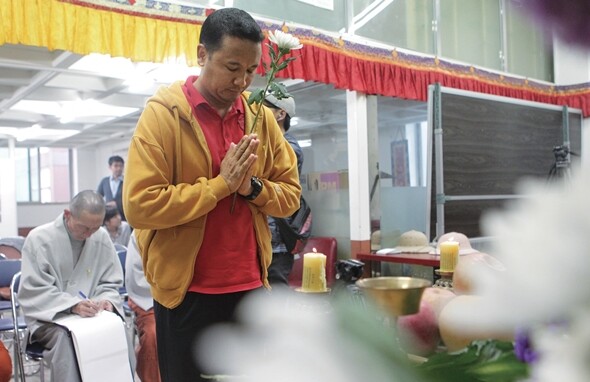hankyoreh
Links to other country sites 다른 나라 사이트 링크
Nepalese who worked in South Korea helping to rebuild their native Nepal

Zone Five of Thulogaun, a village in north central Nepal, is home to an especially large number of people with the family name “Gurung.” The village had around 50 families living in it before it was leveled in the earthquake that rocked the country on Apr. 25. The stone-built houses crumbled, and 26 people lost their lives on the day of the disaster - including one newborn baby.
Late in the evening of May 3, Thulogaun was visited by Sanjib Chapagain, secretary-general of the Nepal Migrant Laborers’ Solidarity Center, and Dallae, a South Korean civic group activist who has worked in Nepal for the past three years. Chapagain, 35, and Dallae, 36, said they drove four hours from Kathmandu before reaching a point where the earthquake had left the road impassable, and had to walk another hour and a half from there. They were greeted by villagers who slung the 25 bags of rice over their shoulders. The villagers with the same family blood equally divided the rice, which is a matter of life and death for them.
The Solidarity Center was established three years ago by about around 100 people who had returned to Nepal after working as migrant laborers in South Korea. Its focus was originally on teaching Nepalis about Korea’s language, culture, and labor rights before they traveled to the country to work.
But when the earthquake struck, the group emptied out its 3 million won (U$2,760) in savings to buy rice and salt. Their new priority was to help the regions that government assistance wasn’t reaching.
With ten years of experience working in South Korea, Sanjib was especially sympathetic to the plight of returning migrant workers.
“The whole village was crying because of the migrant workers who had lost their communities and their families,” he told the Hankyoreh during a long-distance phone interview on May 8.
A similar account was shared by Shamala Tapa, 41. Once the head of South Korea’s first migrant workers’ trade union, Equality Union Migrant Branch, Thapa was deported from the country in 2004.
“About 22% to 25% of all income in Nepal is remittances from migrant workers,” Thapa said.
“Some people came back from overseas to care for their families. Some were planning to leave for abroad, but they’ve had to postpone their departure,” he added.
The Solidarity Center stressed the need not just for short-term rescue efforts, but for long-term support to rebuild communities. One of the group’s projects is “Nepal With Us” (www.facebook.com/nepalwithus). The center is planning to take donations from civic groups and citizens to build new houses in Thulogaun and support residents with their subsistence needs.
“There’s been talk about how it could take ten years to rebuild. Unfortunately, it seems like people’s interest in the Nepal earthquake has been fading over time,” said Dallae.
“I hope the attention and support in South Korea keeps coming.”
By Park Tae-woo, staff reporter
Please direct questions or comments to [english@hani.co.kr]

Editorial・opinion
![[Editorial] Penalties for airing allegations against Korea’s first lady endanger free press [Editorial] Penalties for airing allegations against Korea’s first lady endanger free press](https://flexible.img.hani.co.kr/flexible/normal/500/300/imgdb/original/2024/0502/1817146398095106.jpg) [Editorial] Penalties for airing allegations against Korea’s first lady endanger free press
[Editorial] Penalties for airing allegations against Korea’s first lady endanger free press![[Editorial] Yoon must halt procurement of SM-3 interceptor missiles [Editorial] Yoon must halt procurement of SM-3 interceptor missiles](https://flexible.img.hani.co.kr/flexible/normal/500/300/imgdb/child/2024/0501/17145495551605_1717145495195344.jpg) [Editorial] Yoon must halt procurement of SM-3 interceptor missiles
[Editorial] Yoon must halt procurement of SM-3 interceptor missiles- [Guest essay] Maybe Korea’s rapid population decline is an opportunity, not a crisis
- [Column] Can Yoon steer diplomacy with Russia, China back on track?
- [Column] Season 2 of special prosecutor probe may be coming to Korea soon
- [Column] Park Geun-hye déjà vu in Yoon Suk-yeol
- [Editorial] New weight of N. Korea’s nuclear threats makes dialogue all the more urgent
- [Guest essay] The real reason Korea’s new right wants to dub Rhee a founding father
- [Column] ‘Choson’: Is it time we start referring to N. Korea in its own terms?
- [Editorial] Japan’s rewriting of history with Korea has gone too far
Most viewed articles
- 160% of young Koreans see no need to have kids after marriage
- 2Hybe-Ador dispute shines light on pervasive issues behind K-pop’s tidy facade
- 3Months and months of overdue wages are pushing migrant workers in Korea into debt
- 4Presidential office warns of veto in response to opposition passing special counsel probe act
- 5[Editorial] Penalties for airing allegations against Korea’s first lady endanger free press
- 6Inside the law for a special counsel probe over a Korean Marine’s death
- 7[Reporter’s notebook] In Min’s world, she’s the artist — and NewJeans is her art
- 8Japan says it’s not pressuring Naver to sell Line, but Korean insiders say otherwise
- 9[Exclusive] Hanshin University deported 22 Uzbeks in manner that felt like abduction, students say
- 10At heart of West’s handwringing over Chinese ‘overcapacity,’ a battle to lead key future industries